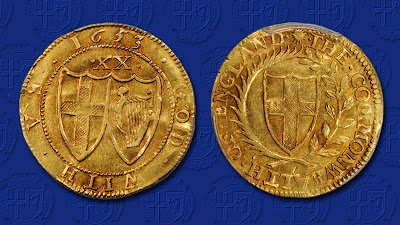
The coin was issued during the Commonwealth period after Charles I was overthrown and the Parliament took over control of the British government. During this time the number of denominations struck by the British government became fewer, and the designs were changed to reflect the anti-monarchial political environment, including changing the legends from Latin to English. It’s a simple design, with the Shield of St. George within a wreath on the obverse and the conjoined shields of St. George and Ireland. This was also the time period of the original agreement that allowed the Massachusetts Bay Colony to begin coinage of Shillings, Sixpence, Threepence, and Twopence; the “NE” coinage began in 1652, and later that year, Willow Tree coins were struck, eventually leading to the Oak and Pine Tree issues.
The survivors of this historic type have a tangible link recalling the turbulent period after the English Civil War, and the rise of Oliver Cromwell to power.





